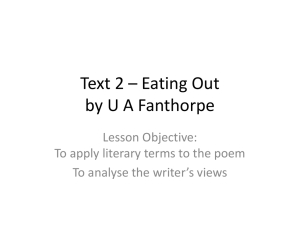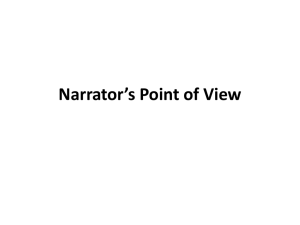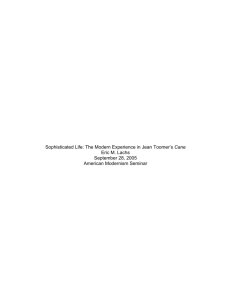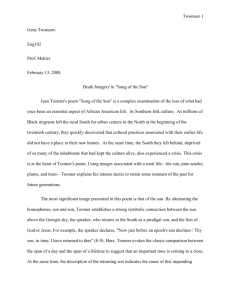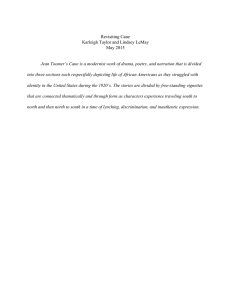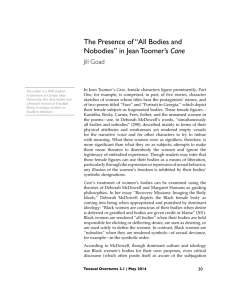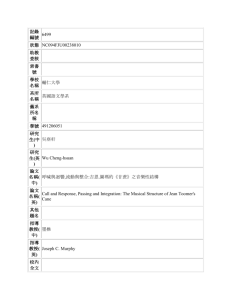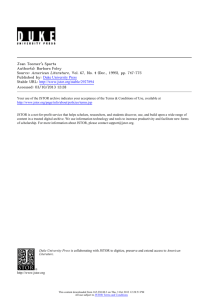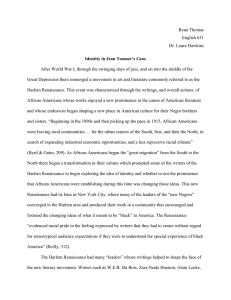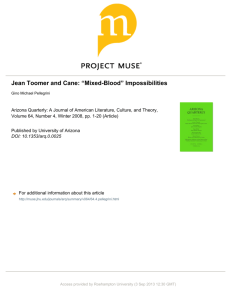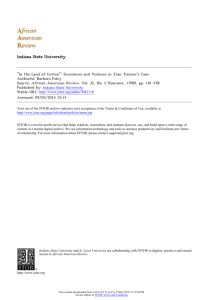The first stories I wrote were all composed while I lay nestled in the
advertisement
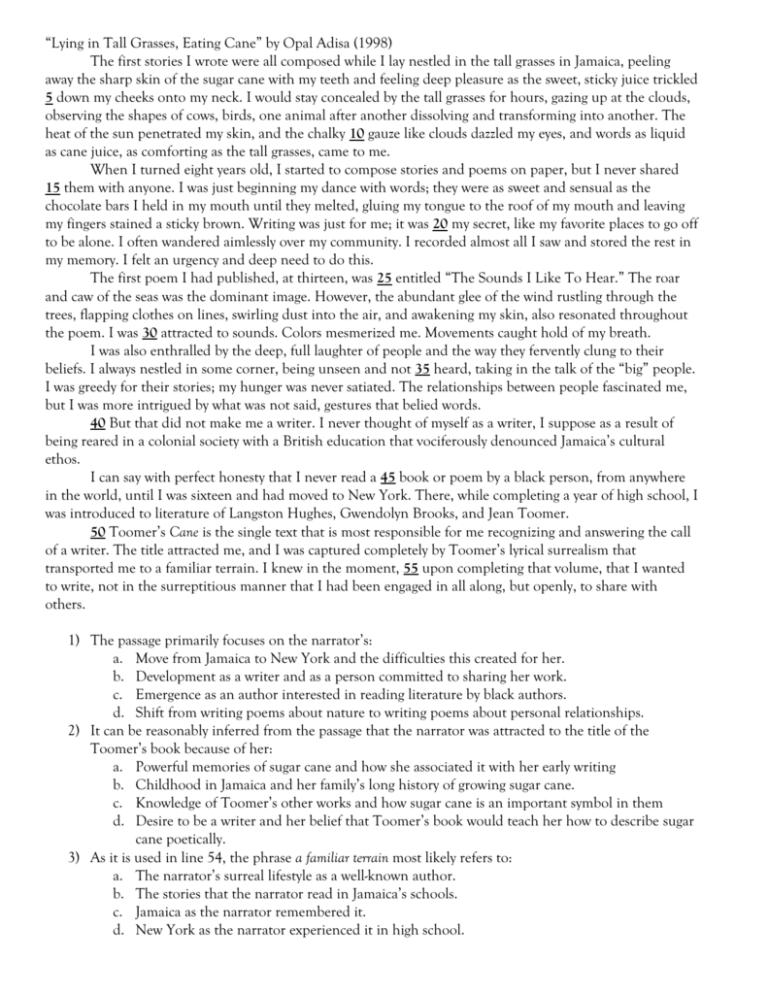
“Lying in Tall Grasses, Eating Cane” by Opal Adisa (1998) The first stories I wrote were all composed while I lay nestled in the tall grasses in Jamaica, peeling away the sharp skin of the sugar cane with my teeth and feeling deep pleasure as the sweet, sticky juice trickled 5 down my cheeks onto my neck. I would stay concealed by the tall grasses for hours, gazing up at the clouds, observing the shapes of cows, birds, one animal after another dissolving and transforming into another. The heat of the sun penetrated my skin, and the chalky 10 gauze like clouds dazzled my eyes, and words as liquid as cane juice, as comforting as the tall grasses, came to me. When I turned eight years old, I started to compose stories and poems on paper, but I never shared 15 them with anyone. I was just beginning my dance with words; they were as sweet and sensual as the chocolate bars I held in my mouth until they melted, gluing my tongue to the roof of my mouth and leaving my fingers stained a sticky brown. Writing was just for me; it was 20 my secret, like my favorite places to go off to be alone. I often wandered aimlessly over my community. I recorded almost all I saw and stored the rest in my memory. I felt an urgency and deep need to do this. The first poem I had published, at thirteen, was 25 entitled “The Sounds I Like To Hear.” The roar and caw of the seas was the dominant image. However, the abundant glee of the wind rustling through the trees, flapping clothes on lines, swirling dust into the air, and awakening my skin, also resonated throughout the poem. I was 30 attracted to sounds. Colors mesmerized me. Movements caught hold of my breath. I was also enthralled by the deep, full laughter of people and the way they fervently clung to their beliefs. I always nestled in some corner, being unseen and not 35 heard, taking in the talk of the “big” people. I was greedy for their stories; my hunger was never satiated. The relationships between people fascinated me, but I was more intrigued by what was not said, gestures that belied words. 40 But that did not make me a writer. I never thought of myself as a writer, I suppose as a result of being reared in a colonial society with a British education that vociferously denounced Jamaica’s cultural ethos. I can say with perfect honesty that I never read a 45 book or poem by a black person, from anywhere in the world, until I was sixteen and had moved to New York. There, while completing a year of high school, I was introduced to literature of Langston Hughes, Gwendolyn Brooks, and Jean Toomer. 50 Toomer’s Cane is the single text that is most responsible for me recognizing and answering the call of a writer. The title attracted me, and I was captured completely by Toomer’s lyrical surrealism that transported me to a familiar terrain. I knew in the moment, 55 upon completing that volume, that I wanted to write, not in the surreptitious manner that I had been engaged in all along, but openly, to share with others. 1) The passage primarily focuses on the narrator’s: a. Move from Jamaica to New York and the difficulties this created for her. b. Development as a writer and as a person committed to sharing her work. c. Emergence as an author interested in reading literature by black authors. d. Shift from writing poems about nature to writing poems about personal relationships. 2) It can be reasonably inferred from the passage that the narrator was attracted to the title of the Toomer’s book because of her: a. Powerful memories of sugar cane and how she associated it with her early writing b. Childhood in Jamaica and her family’s long history of growing sugar cane. c. Knowledge of Toomer’s other works and how sugar cane is an important symbol in them d. Desire to be a writer and her belief that Toomer’s book would teach her how to describe sugar cane poetically. 3) As it is used in line 54, the phrase a familiar terrain most likely refers to: a. The narrator’s surreal lifestyle as a well-known author. b. The stories that the narrator read in Jamaica’s schools. c. Jamaica as the narrator remembered it. d. New York as the narrator experienced it in high school. 4) According to the passage, which of the following events happened first in the narrator’s life? a. She moved to New York. b. She turned sixteen. c. She published her first poem. d. She read Hughes and Brooks. 5) The images in the first paragraph are best described as those of: a. Hopefulness, anxiety, and labor. b. Excitement, disappointment, and warmth. c. Inactivity, peacefulness, and boredom d. Restfulness, enjoyment, and creativity. 6) When the narrator says, “Writing was just for me” (line 19), she most clearly means that she: a. Believed that her writing would eventually lead to a career. b. Found writing to be most enjoyable when she was alone and eating chocolate. c. Knew writing was a secret that she could share with only a few close friends d. Considered her writing to be highly person and private. 7) Based on the passage, the narrator recorded and remembered what she saw in her community in a way best described as: a. Dedicated and thorough b. Careful and hesitant c. Casual and aimless d. Hasty and selective 8) In the poem, “Sounds I Like to Hear,” as described by the narrator, how important is the sea image compared to the wind image? a. Although the sea image is dominant, the wind image is still important. b. Since both images resonate, neither can be considered dominant. c. The sea image’s great important makes the wind image seem insignificant. d. The sea image’s abstractness makes it far less important than the wind image. 9) In terms of choosing to become a writer, the narrator indicates that reading Toomer’s book was: a. Vitally important. b. Somewhat helpful. c. Slightly discouraging. d. Rather insignificant. Answers: 1) B, A is the worst, C and D are just details, not the main focus 2) A, in all other answers, there is not enough evidence to infer that any of those details are true. 3) C-the author wrote about Jamaica in a way similar to how the narrator experienced it, A just uses the word surreal from the text to trick you-she is not a well known author at this point in the story 4) C-she did it at 13. A, B, D kind all happened at the same time. 5) D, all the rest have at least one word of negative connotation. a. Anxiety and labor b. Disappointment c. Boredom 6) D-big picture and abstract, A-she didn’t think it would be a career in line 19, B and C-added misleading details to answer “chocolate” and “friends” 7) C-text said “aimless”, A-not a bad answer as she recorded lots of details and loved doing it, BD-she was not hesitant or hasty 8) A-the right answer is “they are both darn near equal and important” A is the answer that says this most closely 9) A-the text says that the book was “most responsible for me recognizing and answering the call of a writer.”
